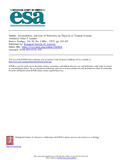| dc.contributor.author | Gaudet, John J. | |
| dc.date.accessioned | 2014-08-18T08:06:31Z | |
| dc.date.available | 2014-08-18T08:06:31Z | |
| dc.date.issued | 1977-03 | |
| dc.identifier.citation | Gaudet, J. J. (1979). Seasonal changes in nutrients in a tropical swamp: North Swamp, Lake Naivasha, Kenya. The Journal of Ecology, 58(2), PP.953-981. | en_US |
| dc.identifier.uri | http://www.jstor.org/stable/1935616 | |
| dc.identifier.uri | http://hdl.handle.net/11295/73794 | |
| dc.description.abstract | Abstract. Analysis of papyrus (Cyperus papyrus L.) indicated that N, P, and K are generally
found in higher concentrations in juvenile stems while Ca, Mg, Fe, and Mn are found in higher
concentrations in mature stems. Iron was found to be concentrated in the roots, while Mn was
concentrated in old umbels. Silicate content increased with age. Potassium and Na were easily eluted
and leached from stems, while other nutrients required more time. Over 50% of all eight elements are
accumulated prior to the attainment of 50% of the biomass. The total amount of nutrients taken up and
accumulated by papyrus (per M2) is higher than most other macrophytes, and this seems to be due to
the high biomass of this aquatic sedge. Estimates of losses due to elution, rain, and decomposition
accounted for approximately two-thirds of the total nutrient accumulated. The remainder is assumed
to be deposited in the swamp as peat. | en_US |
| dc.language.iso | en | en_US |
| dc.publisher | University of Nairobi | en_US |
| dc.subject | Africa; decomposition; elation; macrophytes; nutrient cycling; papyrus; plant nu- trients; rain leaching; swamp detritus; tropical swamps. | en_US |
| dc.title | Uptake, Accumulation, And Loss Of Nutrients By Papyrus In Tropical Swamps | en_US |
| dc.type.material | en_US | en_US |

